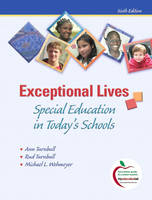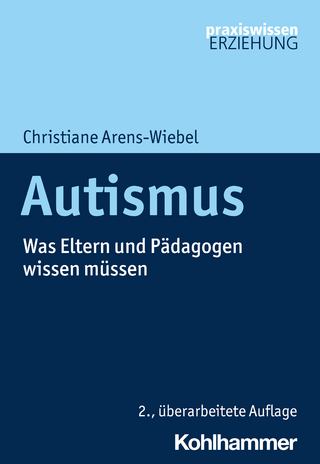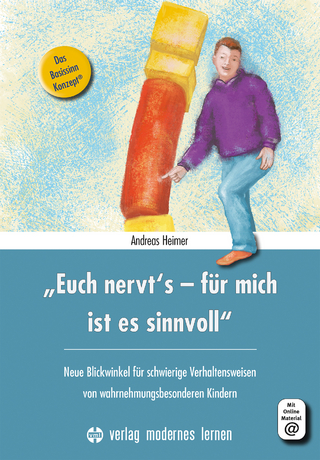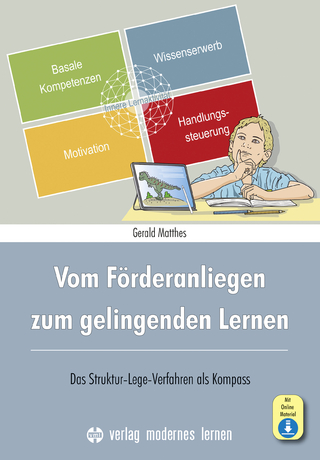
Exceptional Lives
Pearson (Verlag)
978-0-13-502696-0 (ISBN)
- Titel erscheint in neuer Auflage
- Artikel merken
Long noted for its focus on progress in general education through inclusion, families, and parent-professional partnerships, the new sixth edition of Exceptional Lives: Special Education in Today's Schools, now includes a “Values and Outcomes” end-of-chapter feature that focuses on ideal educational results as well as IEP marginal notes that allow readers to link content to practical lessons.
New to this Edition!
NEW! “Values and Outcomes”sections appear at the end of each chapter to discuss the ideal educational outcomes for each student presented in the opening vignette — outcomes that can occur if teachers put highly effective, research-based strategies into practice and uphold the values addressed throughout the book.
NEW! IEP Margin Notes are integrated throughout each chapter to help inform teachers of their role in the IEP process in relation to chapter content video clips on MyEducationLab reinforce this IEP focus. Both IEP features help link content with a practical focus.
MyEducationLab! To package this text with the book-specific version of MyEdLab use this ISBN: 0-136-10141-0
Chapter 3 is completely revised in the sixth edition. See the table of contents for changes.
More in-depth coverage in chapter 2 on the IEP process.
More in-depth coverage of Response-to-Intervention (RTI) in chapter 5.
Contents
Chapter 1 – Overview of Today’s Special Education
Who Is Thomas Ellenson?
Profile of Special Education Students and Personnel in Today’s Schools
Who Are the Students?
Who Are Special Education Personnel?
Overview of the Law and Special Education
Two Types of Discrimination
Judicial Decisions and Legislation
Special Education and Students’ Eligibility
Components of Special Education
IDEA: Six Principles
Zero Reject
Nondiscriminatory Evaluation
Appropriate Education
Least Restrictive Environment
Procedural Due Process
Parent and Student Participation
Bringing the Six Principles Together
Federal Funding of IDEA
NCLB and Other Federal Laws
No Child Left Behind Act
Rehabilitation Act
Tech Act
Special Education Results
Values and Outcomes
What Do You Think?
Addressing the Standards: The Values Connection
Summary
Chapter 2 – Ensuring Progress in the General Education Curriculum Through Universal Design for Learning and Inclusion
Who Is Dani Gonzalez?
What Is “Progress in the General Education Curriculum”?
How Does the General Education Curriculum Benefit Students with Disabilities?
Why Is Progress in the General Education Curriculum Valued?
How Do Supplementary Aids and Services and Universal Design for Learning Support Progress?
What Are Supplementary Aids and Services?
What Is Universal Design?
How Does Universal Design for Learning Facilitate Progress?
How Does Inclusion Support Progress?
What Are Student-Placement Trends?
What Is Inclusion?
What Student Outcomes Are Associated with Inclusion?
How Does Inclusion Facilitate Progress?
How Does a Student’s IEP Support Progress?
Who Designs an IEP and What Are Their Duties?
What Are the Components of the IEP?
Addressing Progress Through the IEP
What Should Educators Do to Support Progress?
Creating Learning Communities
Designing Units and Lessons
Implementing Schoolwide Instructional Strategies
Values and Outcomes
What Do You Think?
Addressing the Standards: The Values Connection
Summary
Chapter 3 -- Issues and Responses in Today’s Culturally Diverse Schools
Who Is De’Ja McGee?
Defining Culture and Its Implications for Special Education
The Social Context of Special Education
History Justifying IDEA
Disproportionate Representation
Risk Ratios
Percentage of Students in Special Education in Different Environments by Race/Ethnicity
Gifted Education Placement
Factors Associated with Disproportionate Representation and Educational Equality
Racial/Ethnic Considerations
Language Considerations
Poverty Considerations
Relationships Among Race-Ethnicity, Language, and Poverty
Becoming a Culturally Responsive Teacher and Advocate
Enhancing Self-Awareness
Increasing Your Knowledge and Experiences of Other Cultures
Implementing Culturally Responsive Instruction
Advocating for Systems Change
Values and Outcomes
What Do You Think?
Addressing the Standards: The Values Connection
Summary
Chapter 4 – Today’s Families and Their Partnerships with Professionals
Who Is the Holley Family?
Who Are Today’s Families?
Defining Family
Demographics of Today’s Families
What Are Partnerships and Why Are They Important?
Defining Partnerships
Importance of Partnerships
How Do Children with Exceptionalities Affect Their Families’ Quality of Life, and What Is Your Role as an Educator?
Emotional Well Being
Parenting
Family Interaction
Physical/Material Well-Being
Exceptionality-Related Support
How Can You Form Partnerships with Families?
Communication
Professional Competence
Respect
Commitment
Equality
Advocacy
Trust
Values and Outcomes
What Do You Think?
Addressing the Standards: The Values Connection
Summary
Chapter 5 – Understanding Students with Learning Disabilities
Who Is Lauren Marsh?
Identifying Students with Learning Disabilities
Defining Learning Disabilities
Describing the Characteristics
Determining the Causes
Evaluating Students with Learning Disabilities
Determining the Presence of a Learning Disability
Determining the Nature of Specially Designed Instruction and Services
Designing an Appropriate IEP
Partnering for Special Education and Related Services
Determining Supplementary Aids and Services
Planning for Universal Design for Learning
Planning for Other Educational Needs
Using Effective Instructional Strategies
Early Childhood Students: Embedded Learning Opportunities
Elementary and Middle School Students: Differentiated Instruction
Secondary and Transition Students: Learning Strategies
Including Students with Learning Disabilities
Assessing Students’ Progress
Measuring Students’ Progress
Making Accommodations for Assessment
Values and Outcomes
What Do You Think?
Addressing the Standards: The Values Connection
Summary
Chapter 6 – Understanding Students with Communication Disorders
Who Is George Wedge?
Identifying Students with Communication Disorders
Defining Communication Disorders
Describing the Characteristics
Determining the Causes
Evaluating Students with Communication Disorders
Determining the Presence of Communication Disorders
Determining the Nature of Specifically Designed Instruction and Services
Designing an Appropriate IEP
Partnering for Special Education and Related Services
Determining Supplementary Aids and Services
Planning for Universal Design for Learning
Planning for Other Educational Needs
Using Effective Instructional Strategies
Early Childhood Students: Facilitative Language Strategies
Elementary and Middle School Students: Graphic Organizer Modifications
Secondary and Transitional Students: Augmented Input
Including Students with Communication Disorders
Assessing Students’ Progress
Measuring Students’ Progress
Making Accommodations for Assessment
Values and Outcomes
What Do You Think?
Addressing the Standards: The Values Connection
Summary
Chapter 7 – Understanding Students with Emotional or Behavioral Disorders
Who Is Matthew Ackinclose?
Identifying Students with Emotional or Behavioral Disorders
Defining Emotional or Behavioral Disorders
Describing the Characteristics
Determining the Causes
Evaluating Students with Emotional or Behavioral Disorders
Determining the Presence of Emotional or Behavioral Disorders
Determining the Nature of Specifically Designed Instruction and Services
Designing an Appropriate IEP
Partnering for Special Education and Related Services
Determining Supplementary Aids and Services
Planning for Universal Design for Learning
Planning for Other Educational Needs
Using Effective Instructional Strategies
Early Childhood Students: Multicomponent Interventions to Prevent Conduct Disorders
Elementary and Middle School Students: Service Learning
Secondary and Transition Students: Conflict Resolution
Including Students with Emotional or Behavioral Disorders
Assessing Students’ Progress
Measuring Students’ Progress
Making Accommodations for Assessment
Values and Outcomes
What Do You Think?
Addressing the Standards: The Values Connection
Summary
Chapter 8 – Understanding Students with Attention-Deficit/Hyperactivity Disorder
Who Is Kelsey Blankenship?
Identifying Students with AD/HD
Defining Attention-Deficit/Hyperactivity Disorder
Describing the Characteristics
Determining the Causes
Evaluating Students with AD/HD
Determining the Presence of AD/HD
Determining the Nature of Specifically Designed Instruction and Services
Designing an Appropriate IEP
Partnering for Special Education and Related Services
Determining Supplementary Aids and Services
Planning for Universal Design for Learning
Planning for Other Educational Needs
Using Effective Instructional Strategies
Early Childhood Students: Multidisciplinary Diagnostic and Training Program
Elementary and Middle School Students: Errorless Learning
Secondary and Transition Students: Cognitive Behavioral and Self-ControlStrategies
Including Students with AD/HD
Assessing Students’ Progress
Measuring Students’ Progress
Making Accommodations for Assessment
Values and Outcomes
What Do You Think?
Addressing the Standards: The Values Connection
Summary
Chapter 9 – Understanding Students with Intellectual Disability
Who Is Stephen Sabia?
Identifying Students with Intellectual Disability
Defining Intellectual Disability
Describing the Characteristics
Determining the Causes
Evaluating Students with Intellectual Disability
Determining the Presence of Intellectual Disability
Determining the Nature of Specifically Designed Instruction and Services
Designing an Appropriate IEP
Partnering for Special Education and Related Services
Determining Supplementary Aids and Services
Planning for Universal Design for Learning
Planning for Other Educational Needs
Using Effective Instructional Strategies
Early Childhood Students: Prelinguistic Milieu Teaching
Elementary and Middle School Students: The Self-Determined Learning Model of Instruction
Secondary and Transition Students: Community-Based Instruction
Including Students with Intellectual Disability
Assessing Students’ Progress
Measuring Students’ Progress
Making Accommodations for Assessment
Values and Outcomes
What Do You Think?
Addressing the Standards: The Values Connection
Summary
Chapter 10 – Understanding Students with Multiple Disabilities
Who Is Sierra Smith?
Identifying Students with Multiple Disabilities
Defining Multiple Disabilities
Describing the Characteristics
Determining the Causes
Evaluating Students with Multiple Disabilities
Determining the Presence of Multiple Disabilities
Determining the Nature of Specifically Designed Instruction and Services
Designing an Appropriate IEP
Partnering for Special Education and Related Services
Determining Supplementary Aids and Services
Planning for Universal Design for Learning
Planning for Other Educational Needs
Using Effective Instructional Strategies
Early Childhood Students: Children’s School Success
Elementary and Middle School Students: The Partial Participation Principle
Secondary and Transition Students: Student-Directed Learning Strategies
Including Students with Multiple Disabilities
Assessing Students’ Progress
Measuring Students’ Progress
Making Accommodations for Assessment
Values and Outcomes
What Do You Think?
Addressing the Standards: The Values Connection
Summary
Chapter 11 – Understanding Students with Autism
Who Is Shawn Jackson?
Identifying Students with Autism
Defining Autism
Describing the Characteristics
Determining the Causes
Evaluating Students with Autism
Determining the Presence of Autism
Determining the Nature of Specifically Designed Instruction and Services
Designing an Appropriate IEP
Partnering for Special Education and Related Services
Determining Supplementary Aids and Services
Planning for Universal Design for Learning
Planning for Other Educational Needs
Using Effective Instructional Strategies
Early Childhood Students: Social Stories
Elementary and Middle School Students: Schoolwide Positive Behavior Support
Secondary and Transition Students: Discrete Trial Teaching
Including Students with Autism
Assessing Students’ Progress
Measuring Students’ Progress
Making Accommodations for Assessment
Values and Outcomes
What Do You Think?
Addressing the Standards: The Values Connection
Summary
Chapter 12 – Understanding Students with Physical Disabilities and Other Health Impairments
Who Is Ryan Frisella?
Who Is Kwashon Drayton?
Identifying Students with Physical Disabilities and Other Health Impairments
Physical Disabilities
Defining Physical Disabilities
Cerebral Palsy: Describing the Characteristics and Determining the Causes
Spina Bifida: Describing the Characteristics and Determining the Causes
Other Health Impairments
Defining Other Health Impairments
Epilepsy: Describing the Characteristics and Determining the Causes
Asthma: Describing the Characteristics and Determining the Causes
Evaluating Students with Physical Disabilities and Other Health Impairments
Determining the Presence of Physical Disabilities and Other Health Impairments
Determining the Nature of Specifically Designed Instruction and Services
Designing an Appropriate IEP 346
Partnering for Special Education and Related Services
Determining Supplementary Aids and Services
Planning for Universal Design for Learning
Planning for Other Educational Needs
Using Effective Instructional Strategies
Early Childhood Students: Token Economy System
Elementary and Middle School Students: Self-Awareness
Secondary and Transition Students: Driver’s Education
Including Students with Physical Disabilities and Other Health Impairments
Assessing Students’ Progress
Measuring Students’ Progress
Making Accommodations for Assessment
Values and Outcomes
What Do You Think?
Addressing the Standards: The Values Connection
Summary
Chapter 13 – Understanding Students with Traumatic Brain Injury
Who Is Dylan Outlaw?
Identifying Students with Traumatic Brain Injury
Defining Traumatic Brain Injury
Describing the Characteristics
Determining the Causes
Evaluating Students with Traumatic Brain Injury
Determining the Presence of Traumatic Brain Injury
Determining the Nature of Specifically Designed Instruction and Services
Designing an Appropriate IEP
Partnering for Special Education and Related Services
Determining Supplementary Aids and Services
Planning for Universal Design for Learning
Planning for Other Educational Needs
Using Effective Instructional Strategies
Early Childhood Students: Collaborative Teaching
Elementary and Middle School Students: Cooperative Learning
Secondary and Transition Students: Problem-Solving and Decision-Making Instruction
Including Students with Traumatic Brain Injury
Assessing Students’ Progress
Measuring Students’ Progress
Making Accommodations for Assessment
Values and Outcomes
What Do You Think?
Addressing the Standards: The Values Connection
Summary
Chapter 14 – Understanding Students with Hearing Loss
Who Are Mariah, Ricquel, and Shylah Thomas?
Identifying Students with Hearing Loss
Defining Hearing Loss
Describing the Characteristics
Determining the Causes
Evaluating Students with Hearing Loss
Determining the Presence of Hearing Loss
Determining the Nature of Specifically Designed Instruction and Services
Designing an Appropriate IEP
Partnering for Special Education and Related Services
Determining Supplementary Aids and Services
Planning for Universal Design for Learning
Planning for Other Educational Needs
Using Effective Instructional Strategies
Early Childhood Students: Facilitative Language Strategies
Elementary and Middle School Students: Graphic Organizer Modifications
Secondary and Transition Students: Augmented Input
Including Students with Hearing Loss
Educational Quality
Educational Placement
Assessing Students’ Progress
Measuring Students’ Progress
Making Accommodations for Assessment
Values and Outcomes
What Do You Think?
Addressing the Standards: The Values Connection
Summary
Chapter 15 – Understanding Students with Visual Impairments
Who Is Haley Sumner?
Identifying Students with Visual Impairments
Defining Visual Impairments
Describing the Characteristics
Determining the Causes
Evaluating Students with Visual Impairments
Determining the Presence of Visual Impairments
Determining the Nature of Specifically Designed Instruction and Services
Designing an Appropriate IEP
Partnering for Special Education and Related Services
Determining Supplementary Aids and Services
Planning for Universal Design for Learning
Planning for Other Educational Needs
Using Effective Instructional Strategies
Early Childhood Students: Programming That Focuses on Real Experiences
Elementary and Middle School Students: Accommodations to Develop Basic Skills
Secondary and Transition Students: Preparing for Adult Life
Including Students with Visual Impairments
Assessing Students’ Progress
Measuring Students’ Progress
Making Accommodations for Assessment
Values and Outcomes
What Do You Think?
Addressing the Standards: The Values Connection
Summary
Chapter 16 – Understanding Students Who Are Gifted and Talented
Who is Briana Hopkins?
Identifying Students Who Are Gifted and Talented
Defining Gifted and Talented
Describing the Characteristics
Determining the Causes
Evaluating Students Who Are Gifted and Talented
Determining the Presence of Giftedness and Talents
Determining the Nature of Specifically Designed Instruction and Services
Designing an Appropriate Education
Partnering for Special Education and Related Services
Determining Supplementary Aids and Services
Planning for Universal Design for Learning
Planning for Other Educational Needs
Using Effective Instructional Strategies
Early Childhood Students: Multiple Intelligences
Elementary and Middle School Students: Schoolwide Enrichment
Secondary and Transition Students: Promoting Creativity and Critical- Thinking Skills
Including Students Who Are Gifted and Talented
Assessing Students’ Progress
Measuring Students’ Progress
Making Accommodations for Assessments
Values and Outcomes
What Do You Think?
Addressing the Standards: The Values Connection
Summary
Appendix
Glossary
References
Name Index
Subject Index
| Erscheint lt. Verlag | 13.2.2009 |
|---|---|
| Sprache | englisch |
| Maße | 210 x 276 mm |
| Gewicht | 1123 g |
| Themenwelt | Sozialwissenschaften ► Pädagogik ► Sonder-, Heil- und Förderpädagogik |
| ISBN-10 | 0-13-502696-2 / 0135026962 |
| ISBN-13 | 978-0-13-502696-0 / 9780135026960 |
| Zustand | Neuware |
| Haben Sie eine Frage zum Produkt? |
aus dem Bereich


